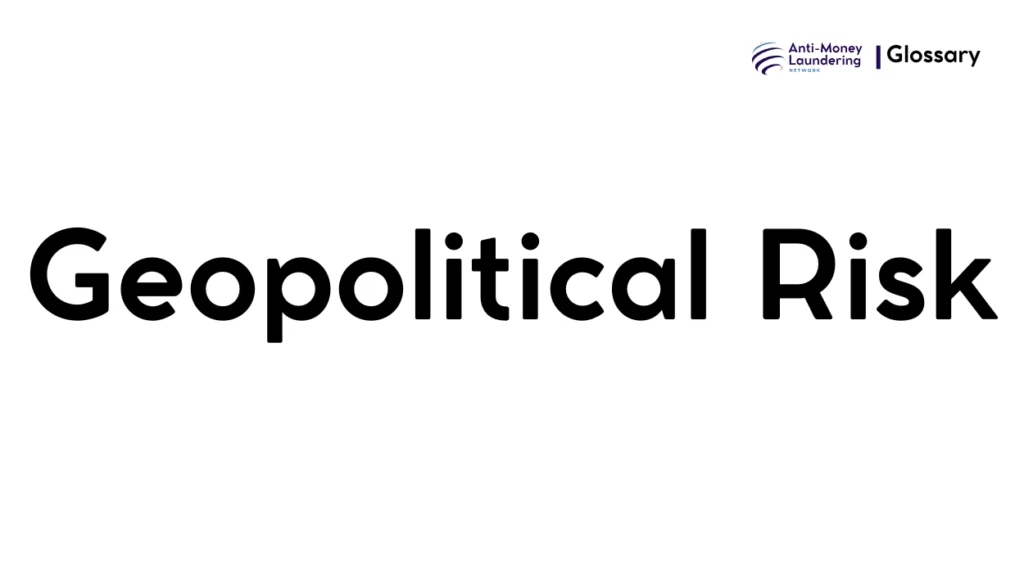Definition
In the context of Anti-Money Laundering (AML), geopolitical risk refers to the potential exposure and threats to financial institutions and compliance frameworks arising from political instability, conflicts, shifting international alliances, sanctions, and regulatory divergences across countries. These geopolitical factors influence the risk landscape for money laundering and terrorist financing by affecting cross-border transactions, sanctions enforcement, and regulatory compliance.
Purpose and Regulatory Basis
Geopolitical risk is central to AML because political and economic instability, along with sanctions regimes, create environments where illicit financial flows can thrive. Regulators mandate financial institutions to assess and manage these risks to prevent facilitation of money laundering or terrorist financing linked to sanctioned entities, conflict zones, or unstable countries. Key global regulations emphasizing geopolitical risk include:
- FATF Recommendations, which require risk-based approaches and ongoing due diligence incorporating country and geopolitical risks.
- USA PATRIOT Act, mandating enhanced due diligence and sanctions compliance for foreign transactions involving high-risk countries.
- EU AML Directives, emphasizing layered assessment of geographic and geopolitical risks affecting money laundering and terrorist financing exposure.
When and How it Applies
Geopolitical risk is invoked when financial institutions conduct due diligence on customers, transactions, or business relationships associated with:
- Countries or regions experiencing conflict, war, or political upheaval.
- Entities or individuals subject to international sanctions or asset freezes.
- Cross-border flows involving jurisdictions with weak AML/CFT frameworks or regulatory gaps.
- Situations involving emerging risks such as state-sponsored illicit finance, corruption, or support of terrorism.
Examples include heightened scrutiny of transactions linked to conflict zones like Ukraine or the Middle East, and ongoing reassessment during geopolitical shifts affecting sanctions regimes or trade restrictions.
Types or Variants
Geopolitical risk in AML can be classified as:
- Conflict-related Risk: Arising from military conflicts or civil unrest impacting sanction enforcement and regional financial integrity.
- Regulatory and Sanctions Risk: Due to shifts in sanctions policies, such as those against states like Russia or Iran, and divergent regulatory controls in emerging markets.
- Alliance and Trade Bloc Risk: Resulting from changing global alliances, trade wars, or embargoes that affect cross-border business.
- Technological and Regulatory Divergence: Different national approaches to data governance and AI regulation influencing compliance landscapes.
Procedures and Implementation
To comply with geopolitical risk obligations, financial institutions should:
- Risk Assessment: Use dynamic risk models integrating geopolitical indicators such as corruption indices, conflict alerts, and sanctions lists.
- Enhanced Due Diligence (EDD): Apply EDD to customers, counterparties, and transactions linked to high-risk countries or sectors.
- Sanctions Screening: Continuously screen against global, national, and regional sanctions lists, adapting swiftly to regulatory changes.
- Intelligence Integration: Leverage open-source intelligence (OSINT), government advisories, and global intelligence networks to monitor geopolitical developments.
- Policy and Training: Develop and update internal policies addressing geopolitical risks and provide relevant training for compliance staff.
Impact on Customers/Clients
From a customer perspective, geopolitical risk may lead to:
- Enhanced scrutiny and verification: Customers from or dealing with high-risk jurisdictions face more rigorous identity verification and transaction monitoring.
- Restrictions or denials: Institutions may restrict services or decline relationships due to elevated risk or sanctions exposure.
- Ongoing monitoring: Continued surveillance of client activity to detect emerging geopolitical risk factors.
- Possible delays in transactions: Especially cross-border transactions involving sanctioned or unstable regions may experience delays or blocking.
Duration, Review, and Resolution
Geopolitical risk management is ongoing and dynamic. Institutions must:
- Regularly review geopolitical risk assessments and update risk ratings as situations evolve.
- Reassess affected clients and transactions periodically or in response to relevant geopolitical developments.
- Document justification for decisions regarding risk acceptance, mitigation, or termination of relationships.
- Resolve flagged issues timely to maintain regulatory compliance and avoid penalties.
Reporting and Compliance Duties
Institutions are responsible for:
- Documenting geopolitical risk frameworks and decisions in AML compliance records.
- Reporting suspicious activities potentially linked to geopolitical risks, such as sanctions evasion or terrorist financing.
- Maintaining audit trails of enhanced due diligence and transaction reviews.
- Demonstrating to regulators proactive management of geopolitical risk as part of overall AML program effectiveness.
- Ensuring penalties compliance for violations related to sanctioned parties or high-risk regions.
Related AML Terms
Geopolitical risk intersects with other AML concepts such as:
- Sanctions Compliance: Ensuring transactions do not involve sanctioned persons or jurisdictions.
- Country Risk: Evaluating the overall AML risk associated with a customer’s geographic location.
- Enhanced Due Diligence (EDD): Additional scrutiny measures tailored to high-risk geopolitical factors.
- Beneficial Ownership Transparency: Critical in revealing ultimate owners obscured behind shell companies in high-risk regions.
Challenges and Best Practices
Common challenges include rapidly shifting geopolitical landscapes, ambiguity in sanctions regimes, and limited transparency in conflict zones. Best practices to address these challenges are:
- Implementing flexible, dynamic risk assessment models capable of real-time updates.
- Collaborating with global intelligence sources and compliance networks.
- Investing in technology such as AI and machine learning to detect hidden risks and beneficial ownership.
- Training staff comprehensively on geopolitical risk awareness and regulatory changes.
Recent Developments
Recent trends impacting geopolitical risk in AML include:
- Increasing complexity of sanctions amid multipolar global politics.
- Growing use of AI-driven analytics for risk detection.
- Greater regulatory focus on emerging technologies and data governance in geopolitical contexts.
- Heightened importance of real-time monitoring of geopolitical events affecting trade, sanctions, and regulatory compliance.
Geopolitical risk in AML is a critical factor shaping compliance efforts worldwide. It encompasses political instability, sanctions, shifting alliances, and regulatory divergences that impact financial crime risks. Vigilant assessment and proactive management of geopolitical risk enable financial institutions to safeguard against money laundering and terrorist financing, comply with international regulations, and protect their reputation.

